
WINDY SPACE
There is a constant stream of gas coming from the Sun. We call this the solar wind because it's a bit like wind that blows on Earth, except it's in space! CMEs of course add a reasonable amount of material to the solar wind and they get carried along by it. Studying how many CMEs there are and where they happen helps us to decide just how much gas CMEs add to the solar wind.
We are still not fully sure how CMEs happen but we do know that the Sun's magnetic field plays a major role.

Image courtesy of the LASCO/SOHO consortium. SOHO is a mission of international cooperation between of ESA and NASA.
These four pictures were taken by the LASCO C1 telescope. It records light that is emitted by the corona. This shows what a CME looks like when it is being born and as it moves out through the corona. The CME pushes outwards as an arch of gas leaving behind an area with less gas than before (black areas in the picture). The edge of the disc that blocks out the Sun can be seen in the bottom right-hand corner.
The Sun, like the Earth, has a magnetic north and south pole - a bit like a bar magnet. There are lots of magnetic lines which go from north to south. These get pushed up into the corona and form giant arches. As the surface of the Sun moves about these magnetic lines get tangled and twisted. This stretches them like elastic bands and just like elastic bands they can snap. This releases a lot of magnetic energy and heat and a CME is born.
Sometimes CMEs are not alone. Solar flares, which are sudden brightenings of small portions of the Sun, can accompany CMEs and some CMEs are followed by the eruption of huge arcs of gas called prominences, which are hundreds of times larger than the Earth.
Check out this LASCO movie (QuickTime, 612Kb) of a prominence. and check out this movie (QuickTime, 190Kb) of a similar event from EIT.
Since CMEs carry a lot of energy and mass away from the Sun and happen so often we must understand them if we want to know how the Sun works. It's like the Sun keeps coughing and we want to know what's making it ill!
LASCO has helped us to understand CMEs better.
If we want to learn what effect CMEs have on the Sun and the Earth we need to know how often they occur. We now know that they are produced more often than we previously thought. Before SOHO was launched it seemed that during the quiet part of the solar cycle one could expect about 1 CME every 10 days. LASCO has now shown us that over 10 days we would really expect about 8 CMES during solar minimum. We have also learned that some CMEs are connected and travel in a family group! Large areas of the Sun can be disturbed by just one CME.
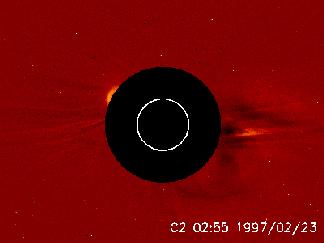
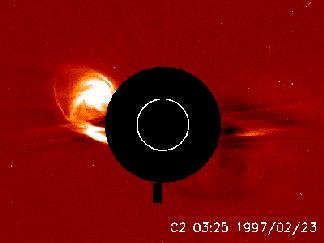
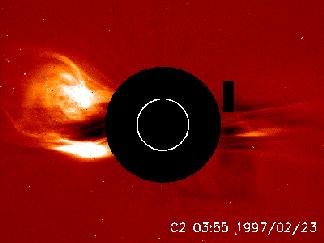
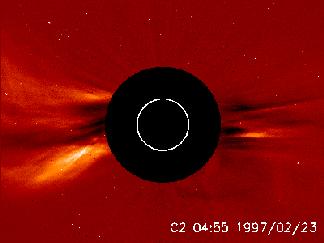
Image courtesy of the LASCO/SOHO consortium. SOHO is a mission of international cooperation between of ESA and NASA.
The images above, taken by the LASCO C2 camera, show how a CME coming from the north-east side of the Sun disrupts the corona along the whole east limb, leading to a much larger CME.
As we approach Solar maximum (around 2001) we expect many more CMEs per day. How many we're not sure. We'll have to wait and see!
CMEs are also bigger than we expected. The first CME seen by LASCO (15th January 1996) taught us that the masses of CME might be seven times more massive than we thought. If we want to make a good model of how the Sun works we need to know how much mass CMEs carry away from the Sun.
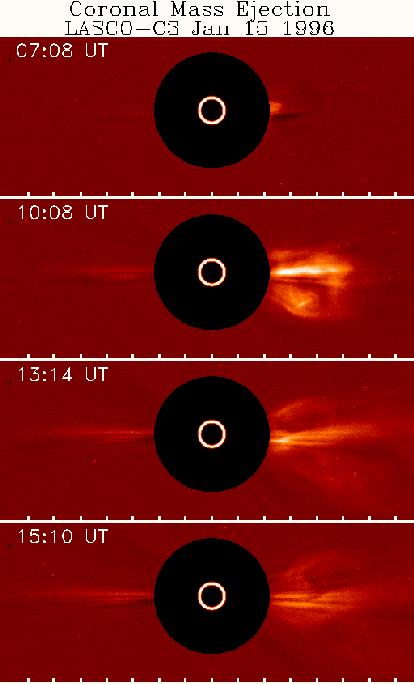
Image courtesy of the LASCO/SOHO consortium. SOHO is a mission of international cooperation between of ESA and NASA.
C3 images of the first CME seen by LASCO. These images and the hundreds of others taken by LASCO since it was launched on SOHO are giving us new views of CMEs and showing us the spectacular side of the Sun!
Using LASCO and other instruments on SOHO we are learning more about how CMEs are born. LASCO shows us the very early stages in the development of CMEs.
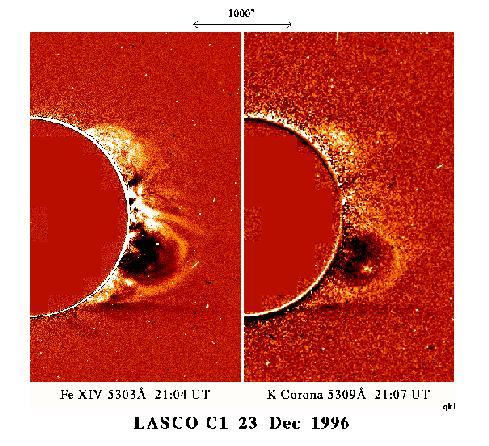
Image courtesy of the LASCO/SOHO consortium. SOHO is a mission of international cooperation between of ESA and NASA.
Both these images were taken by the C1 LASCO telescope. They show a CME (loop shape) as it pushes its way through the corona. The image on the left shows light emitted by the very hot gas in the corona and the image on the right shows light that is scattered from electrons in the corona.
We have also learned that a lot of CMEs accelerate as they move away from the Sun. They have a wide range of speeds but generally they travel at about a million miles an hour.
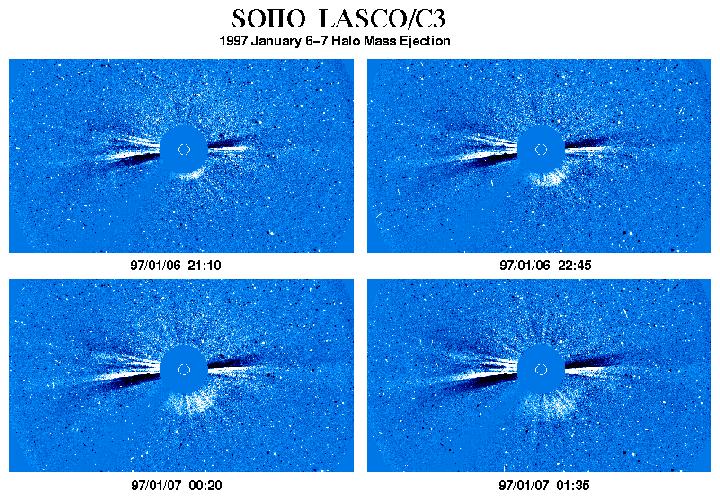
Image courtesy of the LASCO/SOHO consortium. SOHO is a mission of international cooperation between of ESA and NASA.
Watch out! CME on the way! LASCO C3 catches a CME as it heads towards the Earth. Notice that it forms a ring around the Sun and that the white circle in the centre marks the position and size of the Sun.
We can see more CMEs with LASCO than with earlier instruments because LASCO is more sensitive. We can watch CMEs as they move far into space and because LASCO watches the Sun nearly all the time it gives us warnings of when solar storms are going to hit the Earth. Hopefully with the help of other instruments on SOHO we will be able to predict when CMEs are likely to form and come towards Earth. This would be of great benefit to mankind since the charged particles in CMEs can cause a lot of disruption to modern communications and power lines.

|